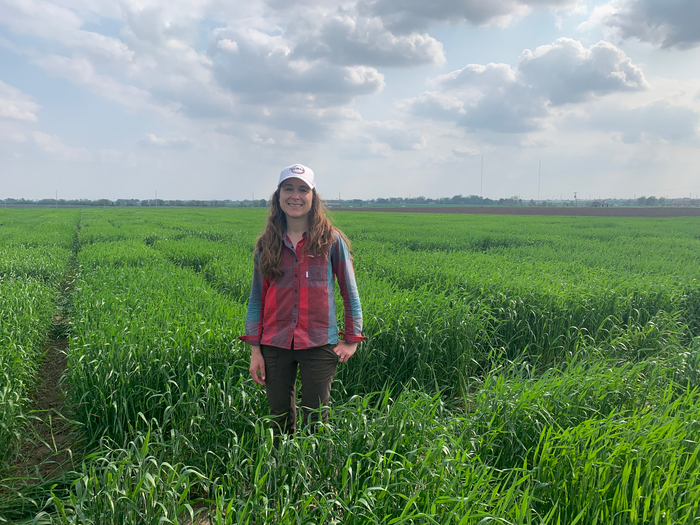Fusarium head blight, commonly called scab disease, is a highly destructive wheat disease that leads to substantial yield loss and contamination of wheat grain with deoxynivalenol.

Jessica Rutkoksi, pictured, is part of a University of Illinois team using cell phone images and AI to detect fungal toxins in wheat kernels. The goal is to quickly identify wheat lines with lower susceptibility to the fungus, making it easier to breed for disease resistance in the crop. Image Credit: University of Illinois College of ACES
Deoxynivalenol (DON) is a mycotoxin that can cause adverse health effects in humans and animals. Phenotyping for Fusarium-damaged kernels (FDKs) provides an accurate assessment of resistance to accumulation of DON; however, it is a time-consuming and subjective process.
A study published in The Plant Phenome Journal implemented sophisticated object recognition technology for filtering out DON-contaminated wheat kernels from the food supply chain and to assist scientists in developing wheat that has stronger resistance to FHB.
Fusarium Head Blight – A Significant Threat to Wheat
Fusarium head blight (FHB) is a serious disease for wheat, causing billions of dollars of losses in crops to date. FHB causes deoxynivalenol buildup in wheat grains. DON is a mycotoxin belonging to the trichothecene family of vomitoxins. FHB is of great concern since DON ingestion in people and animals from infected wheat end products has detrimental effects on health.
In humans, DON consumption may cause nausea, headaches, vomiting, and diarrhea. The adverse health consequences of DON consumption differ amongst animals, but most typically result in weight loss, nutritional deficiencies, and immunological deficiencies.
Detecting Fusarium-Damaged Kernels Using AI
FDK is a well-established visual grain damage caused by Fusarium, which is observed post-harvest. It is used as a ‘proxy’ phenotype to indirectly select for resistance to DON accumulation within the grain.
The team developed a simple and user-friendly method to identify FDKs by training a convolutional neural network (CNN) model on images of healthy and infected wheat kernels.
The images were taken with a smartphone and uploaded to the app, which then used the trained CNN model to determine the percentage of infected kernels. The model achieved an accuracy of around 90% in detecting FDKs in wheat, which was comparable to manual FDK counting.
While alternative techniques for quantifying DON levels in wheat grain samples exist, they entail lab-intensive tests like mass spectrometry (MS) and enzyme-linked immunosorbent tests, which can be costly and time-consuming.
The CNN model used in the study was trained on numerous images of wheat kernels taken with a smartphone, half of which were healthy, and the other half were infected with Fusarium graminearum.
The model was then used to classify new images of kernels as healthy or infected. The researchers tested the model on additional images of wheat kernels, achieving a high accuracy in detecting FDKs in wheat.
Girish Chowdhary, an author of the study, remarked on the novelty of their research, “One of the unique things about this advance is that we trained our network to detect minutely damaged kernels with good enough accuracy using just a few images. We made this possible through meticulous pre-processing of data, transfer learning, and bootstrapping of labeling activities.”
Potential Applications
According to the researchers, the mobile app has the potential to make the process of phenotyping for FDKs more accessible and affordable, especially in developing countries where laboratory assays are not readily available.
It can also be used in the field to identify infected wheat kernels, enabling farmers to monitor FHB in real time and take necessary measures to minimize yield loss and mycotoxin contamination.
The app can also help researchers and industries to screen large numbers of wheat varieties for resistance to FHB and DON accumulation.
The CNN model can be fine-tuned to identify specific resistance mechanisms and to develop wheat varieties that are resistant to FHB and have low DON levels, thus contributing to global food safety and security.
Fusarium head blight remains one of the most destructive diseases in wheat, resulting in significant yield losses and the contamination of wheat grain with deoxynivalenol.
Phenotyping for Fusarium-damaged kernels is a critical component of identifying resistance to DON accumulation in wheat, but manual phenotyping can be time-consuming.
This study has developed and tested an open-access and easy-to-use method for the phenotyping of FDKs using a convolutional neural network trained on cell phone images.
The method achieved an accuracy of around 90% when tested on a separate dataset, demonstrating its potential to greatly improve the efficiency and accuracy of FDK phenotyping.
Future research in this area could focus on further refining the CNN model, as well as combining this method with other technologies to develop a more comprehensive system for monitoring crop health and identifying disease outbreaks.
Reference
Wu, J., Ackerman, A., Gaire, R., Chowdhary, G., & Rutkoski, J. (2023). A neural network for phenotyping Fusarium-damaged kernels (FDKs) in wheat and its impact on genomic selection accuracy. The Plant Phenome Journal, 6(1). https://doi.org/10.1002/ppj2.20065
Disclaimer: The views expressed here are those of the author expressed in their private capacity and do not necessarily represent the views of AZoM.com Limited T/A AZoNetwork the owner and operator of this website. This disclaimer forms part of the Terms and conditions of use of this website.